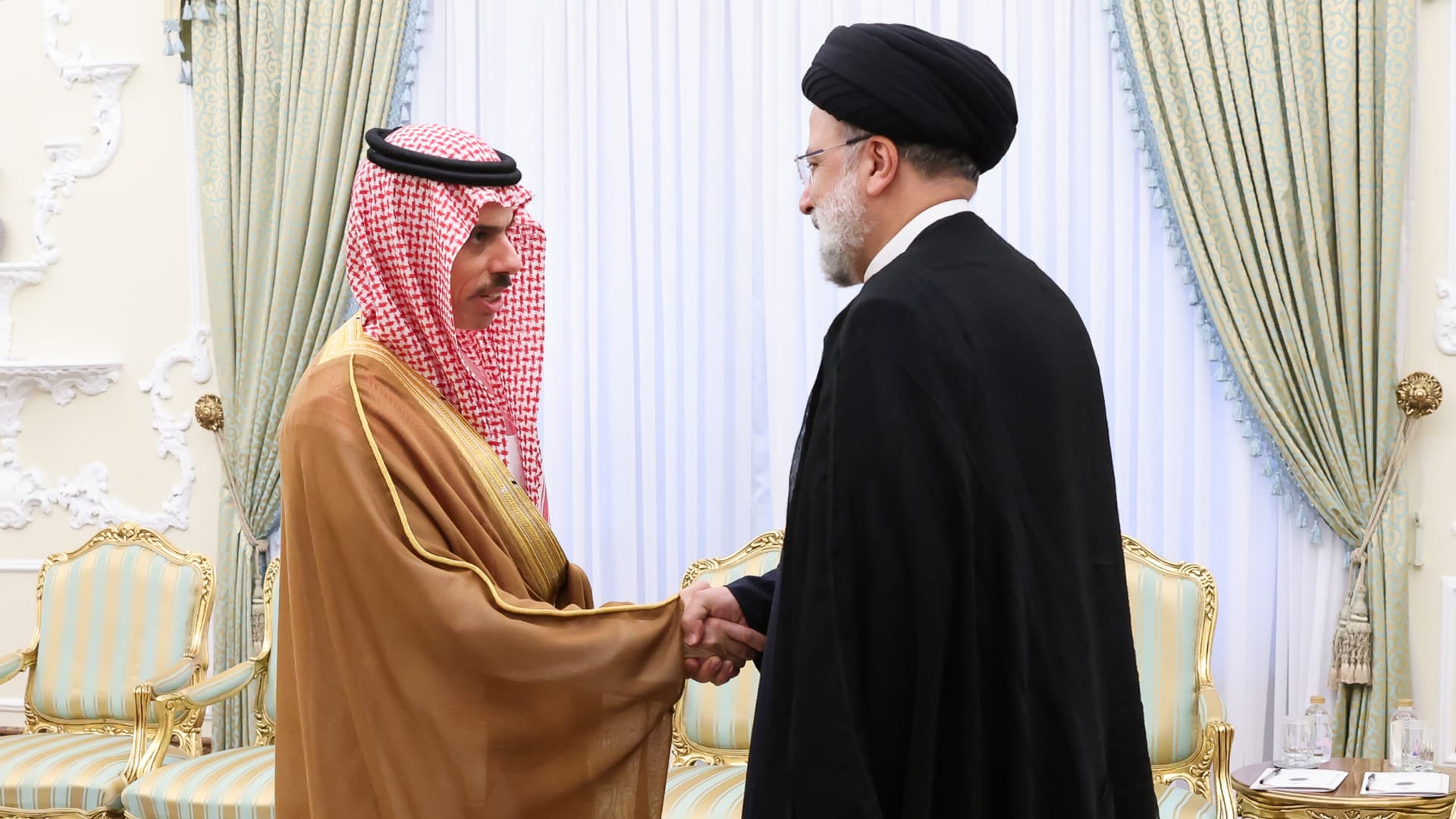Iranian President Ibrahim Raisi (R) meets Saudi Arabian Foreign Minister Faisal bin Farhan Al Saud in Tehran, Iran, June 17, 2023.
President of Iran | Handout | Anadolu Agency | Getty Images
Saudi Arabia’s foreign minister made a high-profile visit to Tehran over the weekend, reporting and praising improvements in relations between Iran and Saudi Arabia, longtime foes.
From now on, “mutual respect, non-interference in the internal affairs of both countries and observance of the UN Charter” will be at the heart of bilateral relations, Saudi Arabia’s top diplomat, Prince Faisal bin Farhan Al Saud, said in a press conference during the visit. .
His Iranian counterpart, Hossein Amirabudolashian, praised the reestablishment of diplomatic ties, saying it would improve security in the region.
The meeting was the result of Iran and Saudi Arabia agreeing to restore diplomatic ties and reopen each other’s embassies following China-led talks in Beijing in March. The rapprochement was a watershed moment for diplomacy in the region.
But many regional analysts say hopes of immediate confidence and alignment may have to wait as the two regional powers continue to diverge sharply over their geopolitical and religious goals.
A small example was evident on Saturday, when the Saudi foreign minister refused to hold a joint news conference in front of a portrait of the late Iranian general Qasem Soleimani, who has commanded Iran for decades Wage a proxy war in the Middle East. The Iranian hosts complied with the minister’s request to change the venue to avoid a diplomatic incident, regional media reported.
Sanam Vakil, of Chatham House’s Middle East and North Africa programme, said: “This meeting has shown us that, despite some delays, both sides are using de-escalation as part of a new regional strategy aimed at reducing tactical threats. a part of.”
“Despite these developments,” she said, “nothing has been resolved between the two capitals. What exists is a fragile agreement that will only grow stronger with time, consistency and trust. .”
“A Longer Process”
Michael Stephens, an associate research fellow at the Royal United Services Institute in London, agrees.
“I think both sides are serious, but I think it’s a much longer process than some commentators have given. Not everything has changed and there’s still a huge gap across the field. Tensions need to be resolved,” he said, citing the war in Yemen – where Tehran and Riyadh support opposing sides – and Iran’s use of proxy militias across the Middle East, as well as attacks on Saudi infrastructure by Iran-backed groups.
Iranian Foreign Minister Hossein Amirabdollahian (right) and his Saudi counterpart Faisal bin Farhan (centre) during a news conference in Tehran, Iran, June 17, 2023. Farhan arrived in Tehran on June 17, his first visit to Iran since the landmark reconciliation after a seven-year rupture.
Martin Gassemi | Borna News | Aksonline ATP Images | Getty Images
Iran and Saudi Arabia have long accused each other of destabilizing the region and view each other as a serious security threat. They are often on opposing sides of regional conflicts, such as those in Yemen, Lebanon and Syria. Both Riyadh and Washington have accused Tehran of being behind multiple attacks on Saudi ships, territory and energy infrastructure over the past few years.
Saudi Arabia severed ties with Iran in 2016 after Iranian protesters stormed the Saudi embassy in Tehran in response to Saudi authorities executing 47 dissidents, including a leading Shia cleric.
mutual benefit
Still, turning the page shows that both countries have common interests to pursue, and realize that they would ultimately benefit more from diplomatic engagement.
“Riyadh and Tehran are driven by economic necessity,” Wakir said. “Breaking the impasse between them could reduce the missile and drone threat over Saudi Arabia – a priority for the success of Vision 2030, and Tehran needs to break free from the shackles of economic isolation and sanctions after months of protests.”
Saudi Arabia has also stressed the importance of maritime security in the Gulf region, from which much of the world’s oil is exported, and where skirmishes with Iran seizing foreign ships have been fairly frequent.
Gas and tanker positions (yellow) recorded in the Gulf from June 12-19, 2019.
Reuters | Reuters Photo
“I would like to mention the importance of cooperation between the two countries in terms of regional security, especially the safety of maritime navigation … and the importance of all regional countries cooperating to ensure that they are free from weapons of mass destruction,” Prince Faisal said While in Tehran said.
Despite enduring divisions and ongoing regional conflict, the visit was “clearly a very important signal, and it’s at the right level, with the right ministers,” Stephens said. “In my view, that’s exactly how the process was built through a series of diplomatic moves that showed goodwill on both sides.”
Prince Farhan also met with Iranian President Ibrahim Raisy and expressed the hope that Raisi would accept the Saudi invitation to visit Saudi Arabia “as soon as possible, God forbid”.
Regional watchers say the process will be slow and subject to interruptions, but it should still be able to move from a tense conversation to a more constructive one over time.
“Broadly speaking, things can only be considered tense,” Stephens said, adding that any change in the U.S. government, especially regarding the Iran nuclear deal, could have a significant impact, or even derail the process .
“But in the end you’re reconciling with the enemy, not with the friend,” he said, “so they’re going to have to accept that the two sides see things very differently.”


